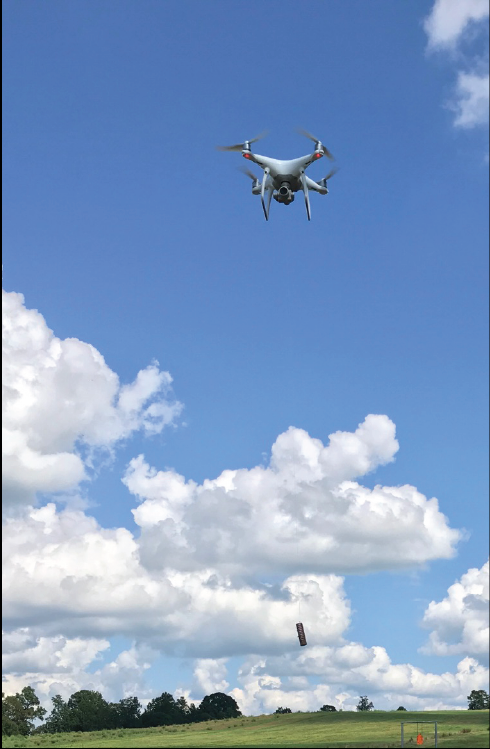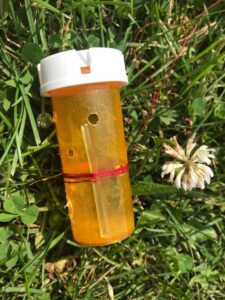Finding DCAs
In the past DCA hunting has involved weather balloons filled with helium, with either caged virgin queens or queen pheromone laced lures dangling below.1 Using either a long pole or string, one would walk around and look for drones flying around the lure. This method is time consuming and the areas limited to open spaces where one can walk under the balloons. With the advent of hobbyist unmanned aerial vehicles (UAVs), commonly called drones, hunting DCAs is much easier. The ability to fly as high as 5,000 meters, videotape and photograph the bees flying below the UAV, and to access areas above trees, make using the UAV a simpler and more accessible method. To avoid confusion, on this website drones refer to male honey bees and UAVs refer to unmanned aerial vehicles.

Tips for using a UAV to hunt DCAs
- Use lightweight thread to suspend lure below your UAV. If it gets caught on something, better to lose your lure than crash your UAV.
New UAVs are getting smaller and smaller. Older UAVs like the Phantom Pro pictured above make it easy to tie thread onto the feet of the UAV and then suspend lure below, but that isn’t possible with a lower profile UAV.
I recommend using an inexpensive cargo drop kit- you won’t be dropping the cargo but just using the band that fits around the UAV that holds a ring to attach your string to.
I like to use lightweight sewing thread to suspend the lure below your UAV. If it gets caught on something, better to lose your lure than crash your UAV. However, thread attached close to the UAV will easily be blown around and can get caught in the propellers. To keep that from happening, use a few feet of thick cord to attach to your drop kit ring, then hang the thread below that.

- Synthetic queen pheromone is the easiest and most cost effective product to use. You can buy it here or here. Consider getting your bee club to purchase a package for members to share.
(Brand name TempQueen.) Stored in the freezer, one lure will last for many flights. It has a two week lifespan out of the freezer.

- Attach the lure to something small that provides some weight as well as a visual marker for both your camera and the drones to see. Plastic hair rollers are inexpensive and readily available, and have the advantage of allowing air to flow through them.

Peel off the fuzzy outer layer to keep the thread from getting tangled in the roller.

A small pill bottle like this one, with a few holes drilled into it for air flow, also will work great.

Photo by Theresa Martin
A little weight helps, but too much will make the lure swing too much.

This lure and hair roller weighs eight grams (.28 ounces) including some jewelry hardware for easy attachment and a key ring at the bottom for additional weight. (You don’t have to use the jewelry hardware, you can just tie the thread onto the feet of your UAV.) When you’re finished for the day, put the whole thing in a plastic bag and store it in the freezer.
- Suspend the lure as far below the UAV as you can manage, to minimize the wind generated by the propellers on the lure. Six meters (20 feet) or more of space between the UAV and the lure will also provide a better picture of how many drones are flying around the lure when observing it from the UAV camera.
Where to look for DCAs
- Many theories about where DCAs are located have been considered, but one that has the most traction is that drones leave their hive and head out where they see depressions in the landscape.2 Flyways often run parallel to treelines, creeks or rivers, and roadways3 and provide clues as to where flyways might occur.
- Google Earth Pro (which is free to use) has a helpful feature that allows you to look at a map and exaggerate the terrain. This is a useful place to begin, looking outward from an apiary. Begin looking at least 200 meters, (1/8 mile) away for depressions in the landscape. Patience is helpful, it can feel like looking for a needle in a haystack.
- 10 or 20 drones may indicate that you’re in a flyway, but a DCA will have hundreds of drones, depending on the time of year and time of day. For a view of what a DCA looks like observed via the camera of a UAV, look at the video on the homepage of this website
- It’s not recommended to fly a UAV on windy days, and drones also prefer to fly in calm weather.
- The temperature needs to be above 64°F (18°C) for drones to fly, so skip the chilly days.
- When you find a DCA, go back and make sure they’re coming back to the same site consistently.
- Drones typically fly in the afternoons. Observe your hive entrances. If you see drones coming and going, then it’s worth heading out to look for DCAs.
- Drones often populate DCAs later in the day in warmer climates like in the Southern US (even though you’ll see them leaving the hives earlier). Try flying once every 30 minutes at the same location for an afternoon if you can, just to make sure you’re not missing them.
- Reach out to UAV enthusiasts in your area and ask them to let you know when they encounter lots of bees while flying. Many UAV pilots stumble upon DCAs without knowing what they are.
Flying a UAV responsibly and safely requires training not addressed by this website. Some things to consider:
- Toys are under 250 grams (8.8 ounces). Anything larger is an Aircraft according to the FAA.
- If you are not being compensated in any way for flying your UAV, you must comply with FAA rules. The FAA Rules are here, and are changing frequently. Stay up to date:https://www.faa.gov/uas/recreational_fliers/
- If you are being compensated in any way:https://www.faa.gov/uas/commercial_operators/become_a_drone_pilot/
- While flying over private property isn’t illegal, you might be met with suspicion. Be prepared to land your vehicle and educate people about what you’re doing, in a respectful manner. If someone asks you to stop flying over their property, honor their request. If you find a DCA and you want to come back for more flights, consider bringing the property owner a jar of honey and telling them about your project.
The fact that a DCA is pinned on this website’s map doesn’t mean that the public has permission to trespass.
1Zmarlicki, C. and Morse, R.A. (1963) Drone Congregation Areas Journal of Apicultural Research 2 (1): 64-66
2Ruttner, F. (1966) The Life and Flight Activity of Drones Bee World: 93-100
3Loper, G.M., Wolf, W.W., and Taylor, O.R (1992) Honey Bee Drone Flyways and Congregation Areas– Radar Observations Journal of the Kansas Entomological Society 65(3): 223-230
